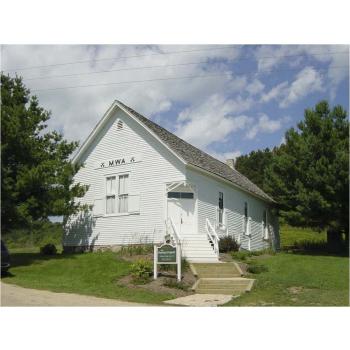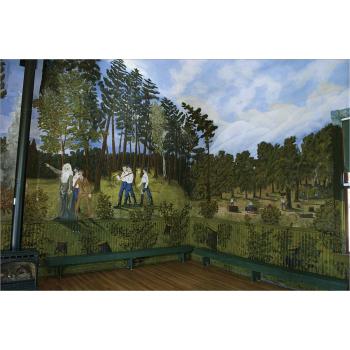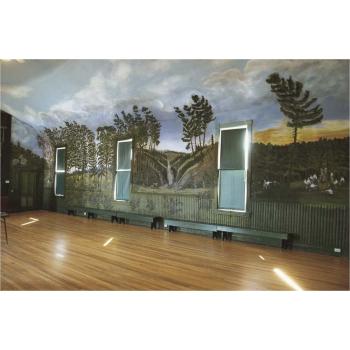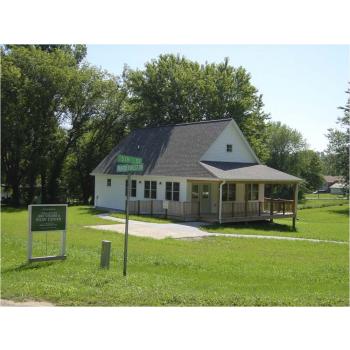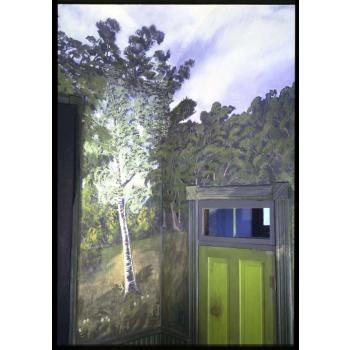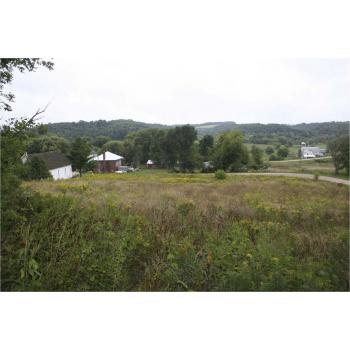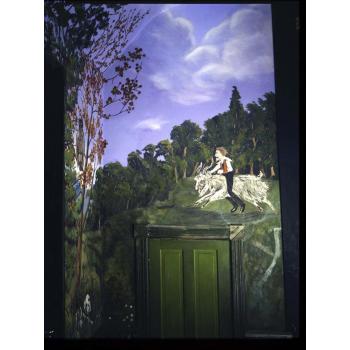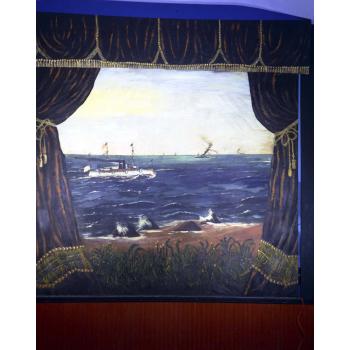Painted Forest
Little documentation exists about the self-taught painter Ernest Hupeden. Born in Germany and educated at a German University, he began painting while imprisoned for a crime he didn’t commit. The man who committed the crime -- embezzlement at the bank where Hupeden had worked -- confessed on his deathbed, and Hupeden was freed. He fled to the United States in 1878.
For several years, he worked throughout southern Wisconsin, often exchanging his paintings for lodging and meals. In addition to painting murals inside homes, on the outside of barns, and other buildings, Hupeden often painted portraits and landscapes on plates and bottles. It wasn’t until 1897 that his most important work began.
That year, Hupeden arrived in the south central Wisconsin town of Valton and took up residence near Modern Woodmen Camp 6190. Like the hundreds of lodge buildings built by the Modern Woodmen of America -- a fraternal life insurance society founded in 1883 by Joseph Cullen Root, primarily to ease the financial burdens of widows and children -- Camp 6190 served as a place to hold local meetings and ceremonies. The Valton building was typical of camp halls: simply designed with an open room and a tall arched ceiling, a small foyer and a second anterior room.
The camp founders already knew of Hupeden’s reputation as an excellent painter and asked him to paint their stage curtain in exchange for his room and board at a local hotel. The painted backdrop for the stage depicted the Battle of Manila and the USS Olympia giving battle to the Spanish fleet. It’s a dramatic scene with waves crashing against a rocky beach and the flags aboard the vessels standing stiff in the breeze. The founders were so pleased with Hupeden’s painting that they hired him to paint the interior walls of the camp hall with scenes depicting Modern Woodmen’s fraternal activity.
By December 1899 after almost two years of work, Hupeden had created a spectacular panoramic mural covering every square inch of the 60’ x 33’ x 24’ building’s interior, including the arched ceiling. Like the founders had requested, the artist’s renderings were literal and symbolic depictions of Modern Woodmen camp activities at the time, documenting a glimpse of the past not found elsewhere in written or oral history. Frightening scenes symbolizing death are counter-balanced with peaceful scenes of home life and fellowship. Tall trees climbed upward onto the arched ceiling, mingling with blue sky and white clouds. Hupeden left behind his vision of a slice of rural Midwestern life that would have been forgotten without his art.
Sometime in the early 1900s, Hupeden was found dead in a snow bank in nearby Hillsboro, Wisconsin. While art historians have continued to search for additional information about this gifted traveling artist, only a few of his works have been found.
The Valton Camp flourished for nearly 20 years, providing the people of Valton with life insurance protection and fraternalism. As America became more urban, Valton became smaller, and eventually Wood Hall ceased to be used for Modern Woodmen meetings. The Modern Woodmen of America network, however, still exists nationwide today and continues to carry out its founder’s vision: fraternal programs to promote positive family life and community service opportunities, helping families gain financial security, not to mention life insurance and annuity products.
The hall was purchased in the 1960s by local residents, Ronald and Delores Nash who named it The Painted Forest. The couple maintained the building and allowed the community to use it for social and political functions.
In 1978, the artistic and historic importance of The Painted Forest as a unique, well-preserved example of Wisconsin folk art was recognized. Kohler Foundation, purchased the site in 1980 and initiated a major restoration using skilled craftspersons from carpenters to artists. For the most part, the murals remain just as they looked in 1899 when Hupeden finished his work. After the restoration was completed, the Foundation presented Sauk County with the deed to The Painted Forest. The Historical Society of the Upper Baraboo Valley provided tours of the historical site. A display of ritual artifacts, donated by Modern Woodmen of America, is also part of The Painted Forest.
Sauk County could no longer care for the site, so it was returned to Kohler Foundation in 2001.
The site was upgraded with heat and air-conditioning, additional conservation was completed, and landscaping was improved to allow for greater accessibility. In October 2004, the site was gifted to Edgewood College of Madison. The College has pledged to continue the site’s role in educating students, artists, researchers, and other visitors. They are committed to the preservation of this unique Wisconsin art treasure.
One year after taking on the Painted Forest, Edgewood College and Kohler Foundation celebrated the dedication of the new Edgewood College Art Studio and Study Center in the Village of Valton. Less than a block from the Painted Forest, the art studio provides studio space, a sleeping loft, a small kitchen, and bathrooms—all things that were not available at the Painted Forest. The addition of the art studio increases the possibilities for lectures, workshops, classes, and other events at the site.
For additional information: ehpaintedforest@gmail.com, (608) 663-2300 or visit https://paintedforest.org/
For information about additional Hupeden works restored by Kohler Foundation, visit the Ernest Hupeden Collection page.
You may also be interested in this documentary film, detailing the masterwork of itinerate artist Ernest Hüpeden covering the interior of the Modern Woodmen of America fraternal lodge in Valton, WI. Made possible by a grant from The Kohler Foundation and Edgewood College.
Ernest Hüpeden - Beyond the Forest
